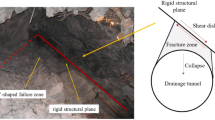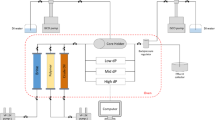Abstract
Cement ring is the main barrier for downhole fluid sealing. The sealing properties of the cement ring include two aspects: sealing off the cement ring itself and the interface. Numerous studies have been conducted on interface sealing failure. However, there are few studies considering the structural perspective of the sealing performance of the complete cement ring itself. Therefore, this study explores pore structure characteristics of cement stone at the microscopic scale, the influencing factors of fluid flow in the cement stone, and the mechanism of sealing performance of the cement stone. The studies have shown that G-grade and ultra-fine cement stones present high porosity and low permeability. Cement stone pores containing free water represent the prerequisite for effective sealing performance. Capillary pressure, resistance caused by ultimate static shear stress, pore fluid pressure, and additional pressure difference produced by the "Jamin effect" are the main driving factors of cement stone sealing fluid. Likewise, as the main driving factors and the length of the cement stone increase, the sealing ability of the cement stone to fluid will follow Enhanced. Considering that water is a non-Newtonian fluid, when the interfacial tension of gas–water is 47 mN/m, the pore diameter is 0.05 μm, the length of the cement stone is 1000 m, the wetting angle is 100°, and the limit dynamic shear stress is 0.01 Pa, the sealing pressure of the cement stone is 543.66 MPa. Our findings provide a foundation for sealing oil and gas reservoirs with different pressure and permeability characteristics.











Similar content being viewed by others
References
Wang, W.; Taleghani, A.D.: Three-dimensional analysis of cement sheath integrity around Wellbores. J. Petrol. Sci. Eng. 121, 38–51 (2014). https://doi.org/10.1016/j.petrol.2014.05.024
Arjomand, E.; Bennett, T.; Nguyen, G.D.: Evaluation of cement sheath integrity subject to enhanced pressure. J. Petrol. Sci. Eng. 170, 1–13 (2018). https://doi.org/10.1016/j.petrol.2018.06.013
Wang, Y.B.; Gao, D.L.; Fang, J.: Assessment of wellbore integrity of offshore drilling in well testing and production. J. Eng. 25, 1419 (2016)
Zinkham, R.E.A.G.: Burst resistance of pipe cemented into the earth. J. Petrol. Technol. 9, 1033–1040 (1962)
Li, Y.; Lu, Y.; Ahmed, R.; Han, B.; Jin, Y.: Nonlinear stress-strain model for confined well cement. Materials 12, 2626 (2019). https://doi.org/10.3390/ma12162626
Zhang, H.; Shen, R.; Li, J.; Xia, Y.; Ban, F.: Elastoplastic analysis of cement sheath of injection & production wellbore under varied casing pressure. Arab. J. Sci. Eng. 43, 6523–6534 (2018). https://doi.org/10.1007/s13369-018-3298-8
Liu, K.; Gao, D.; Yang, J.; Wang, Z.: Effect of expandable cement on increasing sealing ability of cement sheath in shale gas wells. J. Petrol. Sci. Eng. 176, 850–861 (2019). https://doi.org/10.1016/j.petrol.2019.01.077
Kuanhai, D.; Xie, P.; Yue, Y.; Dezhi, Z.; Qiong, L.; Yuanhua, L.: Study on the effect of interface failure between casing and cement sheath on casing stress under non-uniform in-situ stress. Appl. Math. Model. 91, 632–652 (2021). https://doi.org/10.1016/j.apm.2020.10.007
Ravi, M.B.K.: Improve the economics of oil and gas wells by reducing the risk of cement failure, IADC/SPE 74497
Meng, M.; Zamanipour, Z.; Miska, S.; Yu, M.; Ozbayoglu, E.M.: Dynamic stress distribution around the wellbore influenced by surge/swab pressure. J. Petrol. Sci. Eng. 172, 1077–1091 (2019). https://doi.org/10.1016/j.petrol.2018.09.016
Wolterbeek, T.K.T.; Peach, C.J.; Spiers, C.J.: Reaction and transport in wellbore interfaces under CO2 storage conditions: experiments simulating debonded cement–casing interfaces. Int. J. Greenh. Gas Con 19, 519–529 (2013). https://doi.org/10.1016/j.ijggc.2013.10.017
Chi, A., et al.: Present situation research on axial flow displacement theory during cementing. Adv. Petrol. Explor. Dev. 2, 32–37 (2014). https://doi.org/10.3968/j.aped.1925543820130602.1779
Gray, K.E.; Podnos, E.; Becker, E.: Finite element studies of near-wellbore region during cementing operations: part I. SPE Drill. Complet. 24(1), 127–136 (2007)
Bosma, K.: Design approach to sealant selection for the life of the well. J. Petrol. Technol. 14(09), 1033–1040 (1999)
Ravi, K., Bosma, M., Gastebled, O.: Improve the Economics of Oil and Gas Wells by Reducing the Risk of Cement Failure. SPE71106 (2002)
Jiang, G.C.; Sun, J.S.; He, Y.B.: Novel waterbased drilling and completion fluid technology to improve wellbore quality during drilling and protect unconventional reservoirs. Engineering (2021). https://doi.org/10.1016/j.eng.2021.11.014
Teng, Q.; Yang, Z.M.; Liu, X.W.; Xu, X.: Seepage flow field measurement technology in the physical simulation of a low permeability reservoir. Petrol. Sci. Technol. 32, 983–990 (2014). https://doi.org/10.1080/10916466.2011.596885
Huang, H.; Chen, L.; Dang, W.; Luo, T.; Sun, W.; Jiang, Z.; Tang, X.; Zhang, S.; Ji, W.; Shao, S.; Huang, Y.: Discussion on the rising segment of the mercury extrusion curve in the high pressure mercury intrusion experiment on shales. Mar. Petrol. Geol. 102, 615–624 (2019). https://doi.org/10.1016/j.marpetgeo.2019.01.027
Song, H.: Engineering Fluid Mechanics. Springer, Singapore (2018)
Zhong, H.Y.; He, Y.Y.; Yang, E.; Bi, Y.B.; Yang, T.B.: Modeling of microflow during viscoelastic polymer flooding in heterogenous reservoirs of Daqing Oilfield. J. Petrol. Sci. Eng. 210, 110091 (2022). https://doi.org/10.1016/J.PETROL.2021.110091
Rong-Ze, Y.; Qun, L.; Zheng-Ming, Y.; Ya-Nan, B.: Nonlinear flow numerical simulation of an ultra-low permeability reservoir. Chin. Phys. Lett. 27, 74702 (2010). https://doi.org/10.1088/0256-307X/27/7/074702
Farina, A., et al.: Non-Newtonian Fluid Mechanics and Complex Flows. Springe, Cham (2018)
Zhao, Y.W.C.G.: Measurement and calculation of high-pressure interfacial tension of methane+nitrogen/water system. J. Univ. Petrol. (Ed. Nat. Sci.) 1, 75–78 (2002)
Acknowledgements
We would like to thank to National Natural Science Foundation of China (51804332, 51974355), Major scientific and technological projects of CNPC (ZD2019-184-003) and Program for Changjiang Scholars and Innovative Research Team in University (IRT1086) for their 436 support.
Author information
Authors and Affiliations
Corresponding author
Rights and permissions
About this article
Cite this article
Bu, Y., Xu, M., Liu, H. et al. Mechanism of Cement Stone Porosity and Permeability Structures for Downhole Fluid Packing. Arab J Sci Eng 47, 12223–12235 (2022). https://doi.org/10.1007/s13369-022-06943-x
Received:
Accepted:
Published:
Issue Date:
DOI: https://doi.org/10.1007/s13369-022-06943-x




